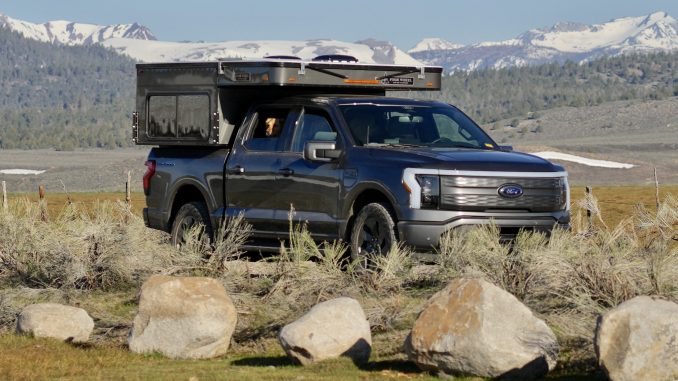
If you live for the great outdoors, you want a truck and a camper as rugged and capable as you. While it’s true that an EV truck burns cleaner, is it up to the task? Can it haul a truck camper? If so, how far can it go without a recharge? Is it capable enough to transport your gear over rocky terrain and get you back to smoother ground when your trip ends? Understanding the range and payload issues associated with today’s EV trucks can help you choose the right ride for your active lifestyle. What’s the truth about EV trucks and truck campers? Let’s find out.
Range and payload defined
Before investing in an EV truck, you should ensure the range and payload suffice for your needs. “Range” refers to how far an EV can travel without a recharge.
The average EV on the road today can go between 110 and 300 miles. That’s plenty if you use your truck primarily to commute to and from the office. However, it can create issues if you’re an overlander or take lengthy trips in your rig. For example, there are over 300 highway miles between Yuma and Flagstaff, Arizona. Those from down south hoping to camp amid the pines better find a charger before they hit the road.
The payload rating, in comparison, refers to the maximum weight you can safely haul without taxing your suspension. It’s a separate rating from the towing capacity, which refers to the maximum weight you can tow. Both the payload and towing capacity impact how far you can go without a charge when loaded with your camper and your trailer. The best way to determine the weight of your rig and any towable is to take it to a CAT scale. The readout provides not only the gross weight of the vehicle, but also the individual weights of the drive and steering axles and any trailer axles (if applicable).
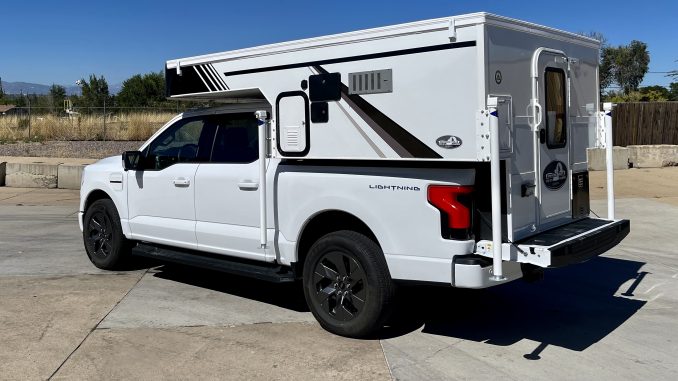
How payload affects range in an EV
Think back to Physics 101. The more resistance an object offers, the greater the force required to move it. The bottom line is the more gear or weight that you add to your EV, the lower the range.
A recent experiment by Arval and the United Test and Assembly Centre in the UK found that a full payload and 500 kilograms (1,100 pounds) of towing reduced an EV’s battery range to between 68.6 percent and 76.94 percent of its unloaded numbers. Factors such as vehicle size and external weather conditions all have an impact on EV range. Running that heater or air conditioner will make your drive more comfortable, but will also drain your vehicle’s battery faster.
Some EV owners report 10 to 20 percent lower range at temperatures below freezing, and generally, the colder it gets the more your EV’s range will be reduced. Evidence suggests that a full payload reduces range by approximately 30 percent. However, cold weather combined with a full payload can be even more detrimental, reducing EV range by as much as 50 percent. Get out the calculator and dust off your advanced calculus degree to determine how far you could go in Arizona, where temperatures can vary by as much as 40 degrees Fahrenheit between the northern and southern halves of the state.
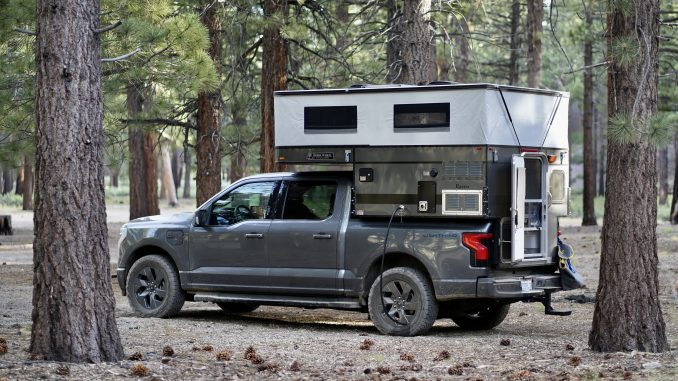
And like the internal combustion engine, having a lead foot can impact range just as well. Throw in the variable for temperature, and the impact on range is even greater. According to the excellent Geotab EV range calculator, a van traveling at 65 mph at 75 degrees can travel 247 miles, while that same van traveling at 65 mph at 28 degrees can go only 222 miles. Lowering the speed to 50 mph at those temperatures extends the range to 292 miles and 249 miles respectively.
Mario Marez, the owner of a Ford F-150 Lightning and a Four Wheel Camper Raven, reports similar results with his Extended Range F-150 Lightning.
“You can definitely get 220 miles on average from an ER Lightning/Raven doing around 65 mph on the highway in fair weather and then about 250 miles on average on a full battery when you are out exploring your camping area. In my hometown of South Lake Tahoe, I am averaging about 250 to 260 miles local driving with the camper on. Residential electric rates cost a little under $16 for a full charge, and about $47 for charging on the road paying for fast chargers. With fast chargers averaging every 50 to 70 miles on the highway you can plan your trip accordingly and enjoy using a Four Wheel Camper Raven at many places on an F-150 Lightning Extended Range. You can’t go far into places as you would a gas truck and camper, but using this setup is still very doable if you keep an eye on your destinations and the range of the truck. Keep in mind if you camp during the winter, the range of a battery will decrease by about a third,” he explained.

Payload, range, and truck campers
Here’s what you must consider regarding payload and range if you intend to haul your camper into the wild with your EV truck. First, gather the following information:
- The average range of your unloaded EV truck.
- Your payload rating, which you can find by subtracting the curb weight—the weight of your vehicle without passengers and gear—from the gross vehicle weight rating (GVWR) of your truck. These numbers can be found on the two placards located on your driver side door pillar.
- The tongue weight of your trailer, which reduces payload capacity even more.
- Your EV truck’s towing capacity which can be found in your owner’s manual.
- The expected temperature and weather conditions.
Calculate whether your electric truck is up to the task of hauling your camper and trailer (if applicable), which you can determine by checking the payload rating and tow rating of your EV truck. Things like the number and weight of the passengers, toys, gear, and full water tanks must be included. For example, hauling a camper with full water tanks and gear increases your camper’s weight considerably.
Assuming you pass the first test, your second task is subtracting the curb and tongue weights from the GVWR of your truck to determine how much it impacts the payload. Your tongue weight is generally between 10 percent and 15 percent of your trailer’s weight.
The calculation is rarely precise—you must also consider temperatures and the weather. Furthermore, without a CAT scale, you might have to estimate the weight of your camper and gear. It’s best to estimate the high and low end of your range and plan your stops accordingly. For example, a heavier payload will reduce your range by at least 8 percent and possibly as much as 50 percent. Pull up a navigation app, search for EV charging locations, and prepare for the best and worst-case scenarios.
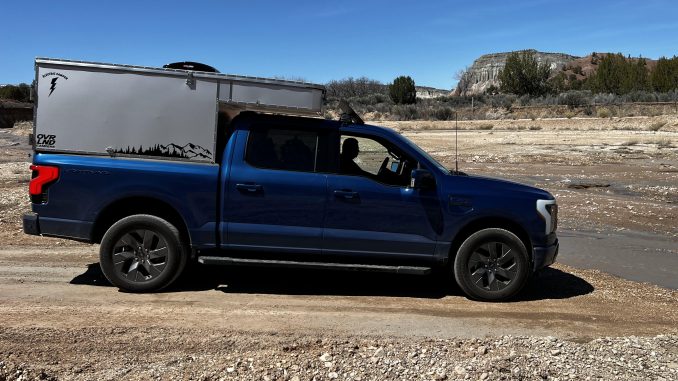
Karin Nyrop, the owner of a Ford F-150 Lightning-OVRLND truck topper, is getting excellent results with her EV setup.
“With about 35,000 miles on the truck, we are around 260 miles of range per charge average, or about an 18 percent reduction in the EPA estimated range with the camper on. If we are driving at high speeds (up at 80 mph) in cold weather with a significant climb (think the Rockies) or significant winds (over 20 mph) we can get as little as 180 miles per charge. This is what happened in Wyoming where we had all three things—wind, low temperature, and significant climb. But driving back roads at average temperatures with limited wind we can get in excess of the EPA rating (this is what happened driving dirt roads in Escalante, Utah last year). Driving around Cape Cod yesterday at varying speeds we averaged around 312 miles per charge. With or without a camper, range is variable and depends a lot on speed, temperature and terrain,” she said.
Today’s EV trucks at a glance
If you’re in the market for an EV truck to fuel your camping ambitions, here’s what’s currently available. Keep in mind that technology evolves rapidly. For example, manufacturers may soon embed ultra-thin solar panels onto your car’s roof to allow you to charge on the go. However, those relying on today’s innovations can choose from the following.
1. Rivian R1T

The folks at Rivian are confirming this R1T’s 1,764-pound payload capacity that accompanies its 11,000-pound towing capacity. It boasts an impressive 420-mile range.
A recent MotorTrend test found cargo minimally impacted the R1T thanks to its four motors. Despite hauling wet and decomposed granite, the truck operated normally and didn’t demonstrate a performance drop off.
The Rivian was one of the first electric trucks, giving the manufacturer time to fine-tune its capabilities. It accelerates like a sports car, going from 0 to 60 in less than 2.5 seconds.
With regards to hauling a camper, however, clearing the Rivian’s roof fin can be an issue though some companies, like Go Fast Campers, have devised a solution. Others will assuredly follow.
2. Ford F-150 Lightning
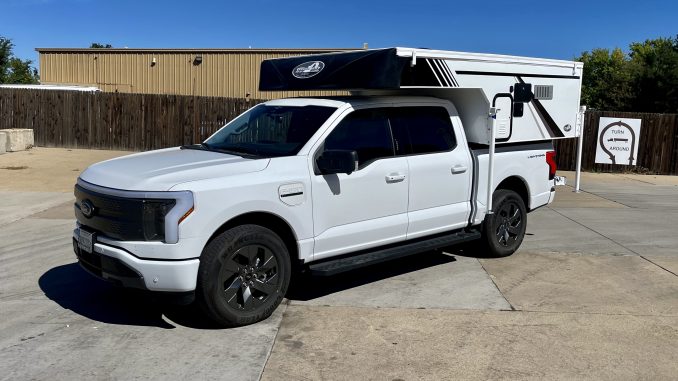
Some consider the Ford F-150 Lightning to be the best electric truck and we agree. How does it stack up when it comes to payload? Ford says the vehicle can handle up to 2,235 pounds with the standard-range battery. With the extended range, the payload drops to 1,952 pounds.
What happens when you use most of the towing capacity? A 2023 AAA study found the F-150 Lightning’s range decreased by 24.5 percent when 110 pounds under its maximum capacity.
The maximum towing capacity of this vehicle is about 10,000 pounds with an extended-range battery—enough to pull many travel trailer models. When unchecked by towing, it gets up to 320 miles of range. If you get the default battery, your towing capacity reduces to approximately 7,700 pounds because of the added weight.
3. Chevy Silverado EV
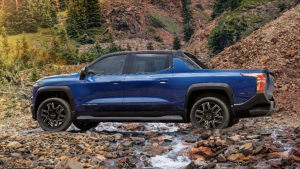
The Chevy Silverado EV is similar to the Lightning with a 10,000-pound towing capacity, though the hauling power differs. Chevrolet offers a 1,750-pound payload if you opt for the 3WT trim level. The 4WT and RST First Edition drop to a 1,400-pound capacity.
However, it provides more range than most competitors at 450 miles. That makes it a better choice for overlanders who take a minimalist approach, perhaps hauling a lightweight truck topper and an e-bike. Hauling more cargo means decreased range, but a drop with the Silverado EV would still let the truck compete with other EVs.
The two front bucket seats and rear bench comfortably hold up to five passengers. It goes from zero to 60 in 4.5 seconds when not burdened with gear and towing.
Unfortunately, the Silverado EV’s “Chevy Avalanche” side flares prevents all production campers from fitting in the bed on the truck. Only a custom camper—like those produced by Phoenix Campers and BundutecUSA—will fit on this truck.
4. Ram 1500 REV
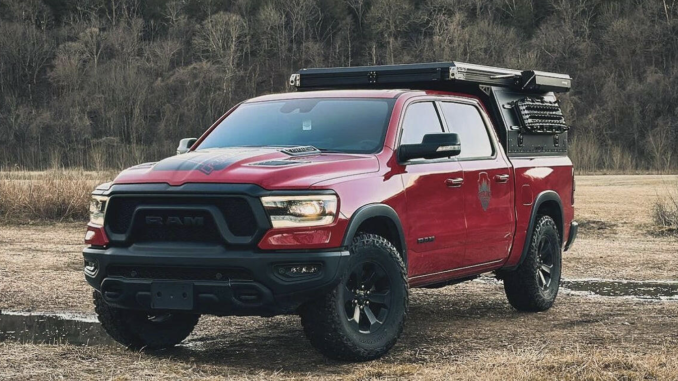 According to the manufacturer, the Ram 1500 REV gets 350 miles of standard driving range and as many as 500 with the larger battery pack anticipated for 2026 models. Its impressive, 2,625-pound payload capacity and 14,000-pound towing capacity provide the capability you need to haul your camper and toys over rough terrain.
According to the manufacturer, the Ram 1500 REV gets 350 miles of standard driving range and as many as 500 with the larger battery pack anticipated for 2026 models. Its impressive, 2,625-pound payload capacity and 14,000-pound towing capacity provide the capability you need to haul your camper and toys over rough terrain.
This vehicle is an excellent choice for big-game hunters who must haul at least one quad on a trailer to cart their elk back to camp. The massive battery packs mitigate the expected drop off, letting you drive far with your RAM 1500 EV.
Ram’s Hands-Free Active Driving Assist feature makes long-haul driving more comfortable by using sensors to maintain a proper following distance from cars. The innovative “frunk”—located where the standard engine would be—adds 15 cubic feet of storage space.
5. GMC Hummer EV
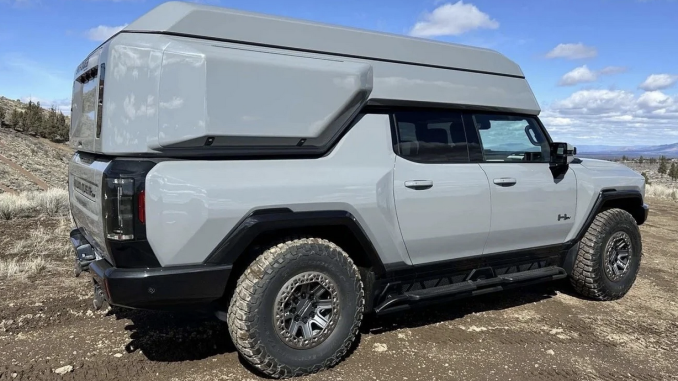 According to EPA estimates, the GMC Hummer EV gets 314 miles per charge. With a 1,485-pound payload capacity, there’s plenty to haul a camper. That said, GMC recommends checking the owner’s manual for the carrying capacity of your electric Hummer. The vehicle is already heavy, so adding a camper and gear does no favors for the hauling or towing capabilities.
According to EPA estimates, the GMC Hummer EV gets 314 miles per charge. With a 1,485-pound payload capacity, there’s plenty to haul a camper. That said, GMC recommends checking the owner’s manual for the carrying capacity of your electric Hummer. The vehicle is already heavy, so adding a camper and gear does no favors for the hauling or towing capabilities.
Its towing capacity tops out at 12,000 pounds—enough to handle many travel trailers with ease. However, according to Car and Driver testing, towing a 6,100-pound trailer resulted in a range of only 140 miles at 70 miles per hour.
One detail that sets this EV truck apart is its optional removable roof panels. It’s perfect for those who camp in their vehicle but want an unimpeded view of the dark, starry skies over BLM land. The moon-shaped details throughout the ride remind you of the brand’s connection to NASA but might also make it cozy to sleep in at night.
6. Tesla Cybertruck
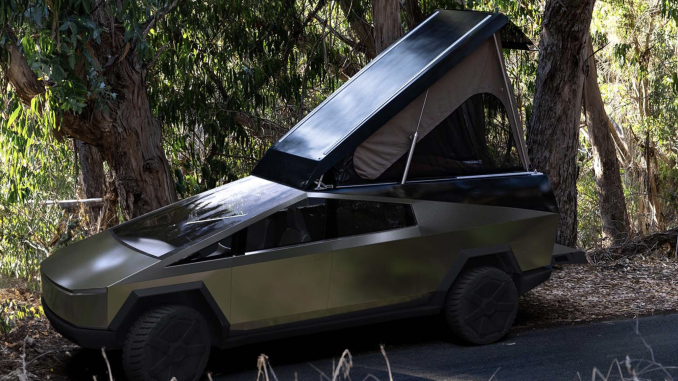 The Tesla Cybertruck may look futuristic, but it stacks up well against the rest of the deck with a 2,500-pound payload and 11,000-pound towing capacity. Furthermore, the super-tough composite bed requires no liner, saving the owner money on accessories. It reportedly can travel up to 340 miles on a single charge.
The Tesla Cybertruck may look futuristic, but it stacks up well against the rest of the deck with a 2,500-pound payload and 11,000-pound towing capacity. Furthermore, the super-tough composite bed requires no liner, saving the owner money on accessories. It reportedly can travel up to 340 miles on a single charge.
Hauling your camper and gear isn’t an issue with the Cybertruck, as the vehicle holds 67 cubic feet of storage. The spacious interior fits sleeping bags, coolers, toolboxes and other necessities. Tesla has planned for a bigger battery to increase the range to 470 miles. However, the extender occupies 1/3 of the bed which limits your cargo space.
The futuristic design of the Cybertruck is distinctly unique. Inside, the rear seats fold for an additional 4 feet of storage space. However, the Cybertruck has perhaps become most notable for several manufacturing issues, recalls and assembly flaws. A total of four recalls have been issued as of this publication date.
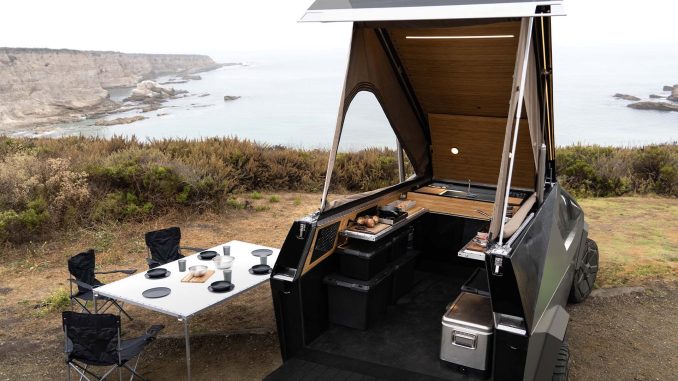
Final Thoughts of EV Trucks
So what’s the truth about EV trucks and truck campers? When it comes to EV technology, the sky is the limit, but we aren’t there yet. No doubt, the technology, the cost to repair and replace the batteries, and the infrastructure to support EV cars and trucks will improve with time. Until we reach that point in time, however, we recommend hauling the lightest, lowest profile camper possible in order to minimize impact on EV range. When considering all options, the truck topper, which weighs anywhere between 300 and 500 pounds, is the best type of camper to haul on an EV truck with the best being made by Four Wheel Campers, OVRLND Campers, and Hiatus. Lightweight slide-in pop-up and hard-side slide-in campers, like those made by Phoenix, Scout, BundutecUSA, and Soaring Eagle, are highly recommended too. Whatever type of camper you choose to haul with your electric truck, aiming for the lightest possible camper that will meet your needs should be the ultimate goal.
“EV truck’s are clearly not for everyone at this point. Going across the US and back has not been simple—it has required a lot of planning which takes time. Fortunately we are retired and can take the time and we have enjoyed the experiment. We wanted an electric truck and the OVRLND Campers truck topper is the perfect match because of how light it is (about 300 pounds). The F-150 Lightning is probably not the best truck for long-distance overlanding. But if you have a base camp for charging it can go out and about on back roads for at least 250 miles if not 300 with a full charge,” Nyrop said.
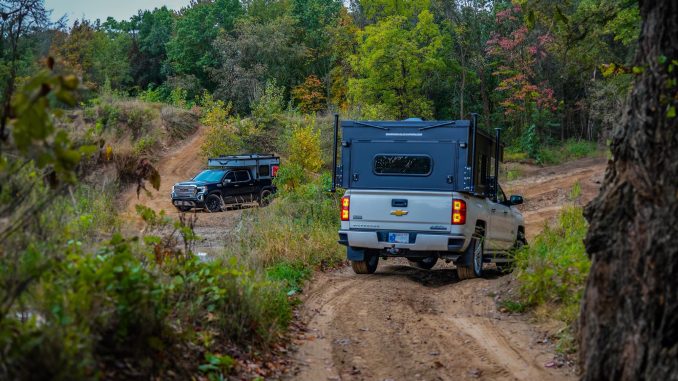













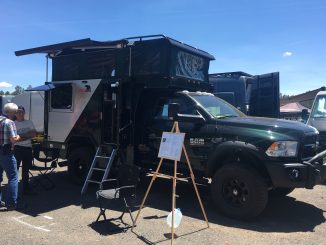
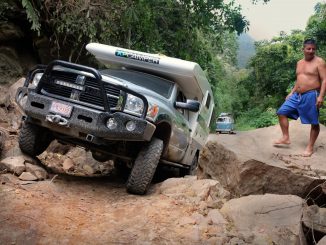
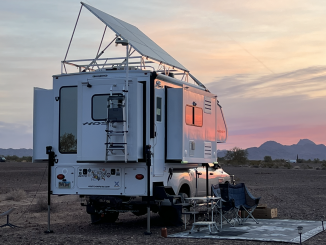
For me a full size 8’ bed hard side truck camper is the minimum. Those shown in the article don’t make the grade. The Tesla truck is not a true camper at all. Besides I think the uselessness of that truck for so many truck functions make it the Edsel of EVs and trucks.
I read this article with mild interest and have been somewhat following EV trucks (not hybrids). The above article shows that some improvements in off-road range have occurred with a given payload and yet still not good enough for me to consider buying one. As the article stated in effect don’t go too far off the beaten track which I agree with in regards to an off-road EV.
For those who want a EV truck be my guest, but keep in mind that the big three are deep in debt over EV trucks and that they are looking for a way to pull out of the EV truck market even if it’s a partial pullout.
One doesn’t really need to be at full charge before hitting the road from Flagstaff to Yuma out of fear you’ll be stranded somewhere in between. As with much of the US, there are 17 charging stations on that route. 10 directly on the route + 7 in Phoenix. Just like you don’t need a full tank of gas on the same route.
When I fuel up I fill up. I have a 750 range with reserve so I can go off road and explore. What truck campers are for.